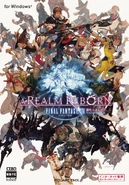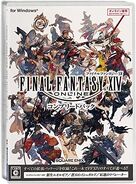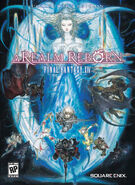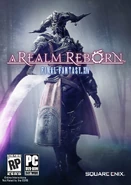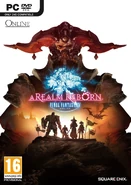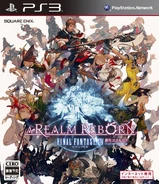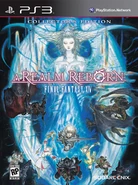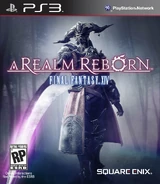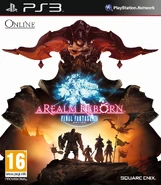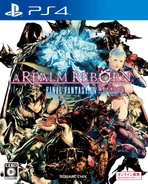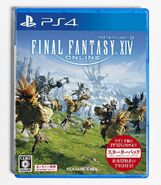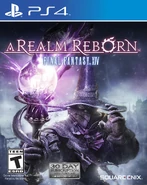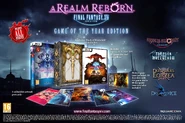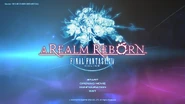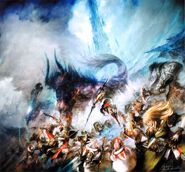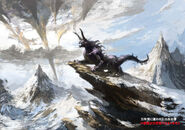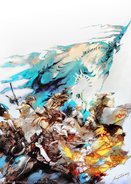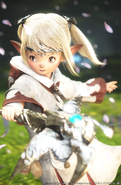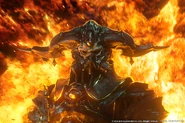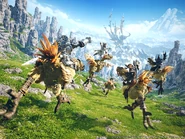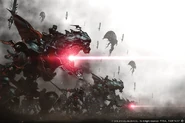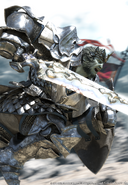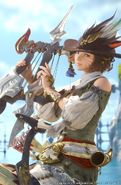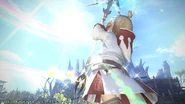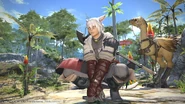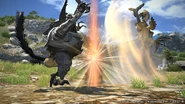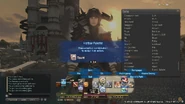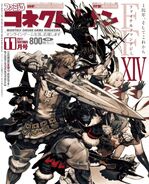
There's no gettin' off this train we on 'till we reach the end of the line.
- For the discontinued version of the game, see Final Fantasy XIV (version 1.0).
Final Fantasy XIV Online, also known collectively with its initial relaunched title Final Fantasy XIV: A Realm Reborn (ファイナルファンタジーXIV: 新生エオルゼア, Fainaru Fantajī Fōtin: Shinsei Eoruzea?, lit. Final Fantasy XIV: Eorzea Reborn), is the relaunched version of the fourteenth installment of the Final Fantasy series and the second, after Final Fantasy XI, to be an MMORPG (Massively Multiplayer Online Role-Playing Game).
The original version of Final Fantasy XIV received heavy criticism at launch in 2010, prompting an official apology and the replacement of its development team. In October, 2011 Square Enix announced the game would be relaunched as Final Fantasy XIV: A Realm Reborn, an entirely new version rebuilt from the ground up. A Realm Reborn would carry over the original game's setting, lore and story, but feature a new client, server structure, graphics engine, interface, terrain, and content.
The original version of the game, termed Version 1.0 or Legacy, received its final update in November 2012 and its service concluded that December. Alpha testing for A Realm Reborn commenced in November 2012, with beta testing following throughout the first half of 2013. The game officially relaunched on Microsoft Windows and PlayStation 3 platforms on August 27, 2013, and then officially launched on the PlayStation 4 on April 14, 2014. Support for the PlayStation 3 version ended in June 2017. Official support for 32-bit operating systems on all personal computers ended in July 2019, though it was possible to continue running the 32-bit version of the game until March 19, 2024. A PlayStation 5 open beta was released on April 13, 2021, and officially entered service on May 25, 2021. A version for Xbox Series X/S entered open beta on February 21, 2024, and officially entered service on March 21, 2024.
The first expansion, Final Fantasy XIV: Heavensward, was released on June 23, 2015 worldwide. The second expansion, Final Fantasy XIV: Stormblood, was released on June 20, 2017. A third expansion, Final Fantasy XIV: Shadowbringers, was released July 2, 2019. A fourth expansion, Final Fantasy XIV: Endwalker, was released on December 7, 2021. A fifth expansion, Final Fantasy XIV: Dawntrail, released on July 2, 2024.
Gameplay[]
After the player has created a character, the game will start in one of the three city-states depending on the character's starting class. The player cannot change class until finishing the level 10 class quest of their starting class.
Doing the Main Scenario quests will help the player gain EXP, gil, items, an airship ticket, an ability to use the inn room, permission to do Guildleves, visit the Gold Saucer, hire retainers, and be able to join Grand Companies.
The player can choose between playing with mouse and keyboard or play on a gamepad. The skill HUD will adapt to the player's selected choice.
Hotbars[]
The game uses hotbars, allowing players to slot in actions into customised bindings. If a player uses a controller, they get access to the Cross Hotbar, a special hotbar made for controllers that has two sides. When the player holds down ![]() /
/![]() the right half of the bar is highlighted, while holding
the right half of the bar is highlighted, while holding ![]() /
/![]() highlights the left half, each allowing eight hotbar slots assinged to the face buttons and the directional pad.
highlights the left half, each allowing eight hotbar slots assinged to the face buttons and the directional pad.
If the player chooses to play with mouse and keyboard, they can use the standard twelve-slot hotbars found hotbar based MMOs; the player can have multiple hotbars on screen simultaneously and bind different key commands to control them. The PlayStation 4, PlayStation 5, and Xbox Series versions also support mouse and keyboard control, however the PlayStation 3 version did not.
Leveling and partying[]
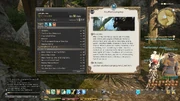
The Duty Finder menu.
There are two main methods of seeking parties: the Duty Finder and the Party Finder. The Duty Finder is a dedicated party search system for undertaking instanced duties. It allows the player to form an allocated party with other players, including players from different worlds (servers) on the same data center. The Party Finder allows recruiting with more varied and specific criteria (such as participating in FATEs).
Players may also manually invite party members at any time.
Free Companies are a guild system, taking the place of Linkshells from the 1.0 release and Final Fantasy XI, which now function more as chat channels for various player purposes. To register a new free company, the player must be level 25, aligned with a Grand Company, have at least four starting members, and 15,000 Gil. However, any player may instead join an existing free company regardless of level by applying for, or being invited into it. Unlike Linkshells, a player may only belong to one Free Company at a time. Free Companies offer several unique ways to play with an established group of players, including a shared housing system and special bonuses.
Battle system[]
Fighting[]
Using skills is an easy learning system. The player has four different battle bars to watch: HP, MP, Enmity, and (in parties) the Limit Gauge.
- HP stands for Hit Points and determines how close a player is to being unconscious. HP is governed by the Vitality attribute.
- MP stands for Magic Points and is used for casting spells (EX: Fire, Blizzard). Although most of these skills have a casting time, there are some instant spells that can be cast while moving. Spells with a cast time require the player to stand still until the casting is complete. Originally, MP was governed by level, as well as the Piety attribute when using a job in the Healer role. However, with the release of the Shadowbringers expansion, MP is instead standarised at 10,000 max for every character, with spells costing specific amounts to balance around this.
Enmity[]
Enmity is a small bar (under the class icon) that measures how much threat they have with a specific opponent while in a party. This gauge is intended to ensure those with a tank role can maintain the enemy's attention, while DPS and healers avoid getting directly attacked.
The bar reflects the proportionate threat compared to other players, showing how likely they are to gain aggro. A number indicates the player's threat ranking, with "A" representing the one holding aggro; if aggro is held by a player or NPC out of party or a pet not shown on party list, the highest will be represented as "1".
By default, enmity is not shown when playing solo, where it usually is irrelevant. However, these mechanics will still be in place whenever multiple players or NPCs attack a target (such as during FATEs).
Limit Break[]
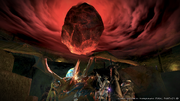
A Black Mage using a limit break.
A Realm Reborn implements a limit break system for parties in place of the Battle Regimen system found in Version 1.0. Each party has a limit gauge that increases as specific actions happen during battle. When at least one section of the gauge is filled, a limit break may be activated by a party member, emptying the gauge. The effects of the limit break are dependent on the class or job of the character who triggered it, while the strength of those effects is based upon how many sections of the limit gauge were filled when the limit break was triggered. A tank class will increase the defense of the party with their Limit Break, a healer will use a healing effect that can raise at level 3, a physical melee DPS will unleash a powerful attack on one target, magic DPS will loose a circular area blast, and physical ranged DPS will fire an area blast in a straight-line.
The rate at which the limit gauge is filled changes in response to the conditions of battle. Executing certain skillful maneuvers, such as inflicting the Stun status effect on an enemy, can make the limit gauge rise more quickly. Conversely, the death of a party member will cause the limit gauge to decrease by a certain amount. The limit gauge will also fill more slowly if multiple party members are using the same class or job at one time.
Crafting system[]
Synthesis[]
Crafting is initiated through the Crafting Log, provided materials are available in inventory. Players must use abilities to advance the progress and quality of the crafted item. Increasing progress gradually leads to completion of the item, while increasing quality increases the chance of a HQ (high quality) product and increases EXP gained. While performing actions, the materials Durability will gradually decrease; if it reaches zero, crafting fails and materials may be lost.
At each step, the materials may be in one of four states: Normal, Good, Excellent, and Poor. Good and Excellent will provide bonus to quality gained if the relevant skills are used at that step. Poor occurs right after Excellent, and will penalize any quality gains, but does not affect progress or other skills. Some skills can only be used while in Good condition.
Synthesis is governed by three stats:
- Craftsmanship: Affects how much progress is increased by when using corresponding abilities.
- Control: Affects how much quality is improved by when using corresponding abilities.
- CP: Stands for Crafting Points and is used for various skills during synthesis. Players must manage this so it doesn't deplete too quickly, and some abilities can restore CP in certain conditions.
Materia melding[]
By completing the appropriate quest, players can also meld Materia on to crafted gear. Melding requires the appropriate materia and an appropriately leveled crafter. Most crafted equipment will have at least one slot available for melds. Note that special gear awarded from quests, dungeons, raids, or trials cannot be melded.
Overmelding can also be performed by unlocking the "Advanced Melding" ability, which enables extra materia to melded onto gear. This process may fail, costing the materia regardless, making it financially risky.
Players lacking the necessary crafting skill can "Request Meld" from another player, provided they possess the required items. The interface enables a tip in gil to be given for services rendered.
Repairs[]
While most players can pay certain NPC menders to repair their gear, crafters can use Dark Matter to perform the repairs manually. Starting with Patch 2.28, players can perform repairs regardless of current class as long as the associated Disciple of the Hand class is high enough. Manual repairs will increase current durability by 100% (up to 199%), allowing them to go longer without needing repairs. To perform repairs, the crafting class must be at least ten levels lower than the item's required equip level. Dark Matter repairs can be performed at any time, even during combat.
Desynthesis[]
Players can also perform Desynthesis on equipment, fish, and other certain items to break them down into components, including rare items not obtained in any other circumstance. This is possible once the associated Discipline of the Hand is at least level 30 (regardless of current class). Desynthesis is handled by its own skill rating (per discipline), which affects the chance of success and is increased by successful desynthesis.
Gathering system[]
Gathering is performed by reaching the respective node in the field, which brings up a list of items to retrieve, along with the chances of success and the frequency of a high-quality item being obtained. As items are gathered, nodes will lose "health" until it is depleted. Individual nodes will refresh as others are depleted.
Fishing is a more straightforward (but completely random) process, that simply requires casting line at a body of water and waiting for something to bite. Unlike other classes, consumable bait is required to fish.
Gathering is governed by three stats:
- Gathering: Affects how likely an item can be successfully harvested or fished up.
- Perception: Increases the chance of obtaining a high-quality item. Without the use of abilities, the chance is capped at 15%.
- GP: Stands for Gathering Points and enables certain abilities to aid in gathering. Maximum GP is set at 400, but unlike TP, it can be increased with better equipment, materia, and certain food.
Armory system[]
Final Fantasy XIV uses a job system called the Armory System. Classes are divided among four base disciplines—the physical combat based Disciples of War, the magical combat based Disciples of Magic, the crafting based Disciples of the Hand, and the gathering based Disciples of the Land. Each class has its own weapon type, and changing classes is as simple as equipping the appropriate weapon or tool. Classes can be changed at any time, except during a battle.
In patch 1.21 of the original version, classic Final Fantasy jobs were introduced in place of the combat classes by equipping a soul crystal, which can be acquired and equipped at level 30. Initially jobs were more specialized versions of their base class with exclusive skills and better attributes, while classes retained some viability thanks to their having greater access to cross-class skills for superior versatility. As the game progressed however, the cross-class system was phased out, removing any niche the base classes may have had, leaving jobs as outright replacements. New jobs added since Heavensward do not have base classes.
| Base discipline | Job | Base class | Initial level | Role | Weapon | Release |
|---|---|---|---|---|---|---|
| Disciples of War | 1 | Tank | Swords | Version 1.0 | ||
| 1 | Melee DPS | Fist weapons | Version 1.0 | |||
| 1 | Tank | Axes | Version 1.0 | |||
| 1 | Melee DPS | Polearms | Version 1.0 | |||
| 1 | Physical ranged DPS | Bows | Version 1.0 | |||
| 1 | Melee DPS | Dual daggers | A Realm Reborn | |||
| 30 | Tank | Greatswords | Heavensward | |||
| 30 | Physical ranged DPS | Firearms | Heavensward | |||
| 50 | Melee DPS | Katanas | Stormblood | |||
| 60 | Tank | Gunblades | Shadowbringers | |||
| 60 | Physical ranged DPS | Chakrams | Shadowbringers | |||
| 70 | Melee DPS | Scythes | Endwalker | |||
| 80 | Melee DPS | Twin blades | Dawntrail | |||
| Disciples of Magic | 1 | Healer | Wands and staves | Version 1.0 | ||
| 1 | Magical ranged DPS | Scepters and staves | Version 1.0 | |||
| 1 | Magical ranged DPS | Books | A Realm Reborn | |||
| 30[note 1] | Healer | Books | A Realm Reborn | |||
| 30 | Healer | Star globes | Heavensward | |||
| 50 | Magical ranged DPS | Rapiers and foci | Stormblood | |||
| 1 | Magical ranged DPS | Canes | Stormblood | |||
| 70 | Healer | Nouliths | Endwalker | |||
| 80 | Magical ranged DPS | Paintbrushes | Dawntrail | |||
| Base discipline | Class | Initial level | Role | Primary tool | Release | |
| Disciples of the Hand | 1 | Crafter | Saws | Version 1.0 | ||
| 1 | Crafter | Hammers | Version 1.0 | |||
| 1 | Crafter | Hammers | Version 1.0 | |||
| 1 | Crafter | Hammers | Version 1.0 | |||
| 1 | Crafter | Knives | Version 1.0 | |||
| 1 | Crafter | Needles | Version 1.0 | |||
| 1 | Crafter | Alembics | Version 1.0 | |||
| 1 | Crafter | Skillets | Version 1.0 | |||
| Disciples of the Land | 1 | Gatherer | Pickaxes | Version 1.0 | ||
| 1 | Gatherer | Hatchets | Version 1.0 | |||
| 1 | Gatherer | Fishing rods | Version 1.0 | |||
Characters[]
Playable characters[]
- Warrior of Light - The player can create a character to play as through the use of the character creation system.
Temporary playable characters[]
These characters are available as temporarily playable in Main Scenario instanced duties. They utilize a limited, simplified form of their kits, and often come with additional self sustain options through potions or healing spells.
- Alphinaud Leveilleur (4.3, 6.0)
- Y'shtola Rhul (4.4)
- Hien Rijin (4.5)
- Thancred Waters (5.0, 6.0)
- Branden (5.0)
- Lamitt (5.0)
- Renda-Rae (5.0)
- Nyelbert (5.0)
- Estinien Wyrmblood (5.1, 6.0)
- G-Warrior (5.3)
- Alisaie Leveilleur (5.55, 6.0)
- Urianger Augurelt (5.55, 6.0)
- G'raha Tia (5.55, 6.0)
- "Garlean Soldier" (6.0)
- Zero (6.3)
- Godbert Manderville (6.35)
- Wuk Lamat (7.0)
NPC party members[]
In patch 3.4, Adventurer Squadrons were added to the Grand Company rank system, which allow players to play with three NPCs, recruited through their associated Grand Company. Specific NPCs can be recruited through completing the Challenge Log, an in-game list of tasks the player can choose to do throughout the week. Adventurer Squadrons are limited to instanced dungeons under level 60.
The Trust System was introduced in Shadowbringers, allowing the player to recruit up to three NPCs to take on a Duty in place of matching with other players via the Duty Finder. These characters may join them both during and after they complete the Main Scenario quests, and are typically characters important to the ongoing narrative.
For a list of available Trust party members and available adventurers for Squadrons, refer to their specific pages.
Playable races[]
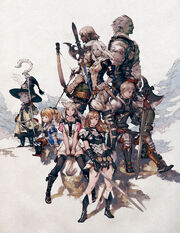
Artworks of the races and various Classes illustrated by Akihiko Yoshida.
There are eight playable races, the initial five of which resemble those from Final Fantasy XI. Each is divided into two clans. The choice of clan has a slight effect on the player's primary attributes, but the difference between the best and worst tribes in an attribute is 5, an insignificant amount compared to that granted by levelling and equipment.
In the game's initial release, there were three "missing genders"—Female Roegadyn, Male Miqo'te and Female Highlander Hyur—but these became available on the launch of A Realm Reborn.[2]
- The Hyur are a race not originally from Eorzea, having migrated there and bringing their technology with them. They are split into two clans, the Highlanders and the Midlanders. They are similar to Humes from Final Fantasy XI.
- The Lalafell are a race from the seas south of Eorzea. The race consists of the Plainsfolk and the Dunesfolk. They are similar to the Tarutaru.
- The Miqo'te are a race from Eorzea, and like the Hyur, are not native to the region. Miqo'tes are either Seekers of the Sun or Keepers of the Moon. They are cat-like beings, similar to the Mithra.
- The Roegadyn are a tall, burly race from the seas north of Eorzea. This maritime race is broken into two tribes: the Sea Wolves and the Hellsguard. They are like the Galka, though they lack tails.
- The Elezen are the race that has lived in Eorzea the longest and co-exist peacefully with the other races. Elezen can either be Wildwood Elezen or Duskwight Elezen. They are similar to the Elvaan.
- The Au Ra are the sixth playable race, introduced in Heavensward. They originate from the Far East. They are divided into two tribes: Raen and Xaela. They appear to be half-human, half-dragon, but are explained by the producers to be more of part-demon in origin.
- The Viera are the seventh playable race, introduced in Shadowbringers. They originate from southern Othard. Viera are divided into Rava and Veena. Only females were playable when they were originally added, with male Viera added in Endwalker. They are based on the race of the same name found in games set in Ivalice.
- The Hrothgar are the eighth playable race, introduced in Shadowbringers. They originate from Ilsabard. This bestial race is divided into Helions and the Lost. Only males were initially playable when they were introduced, with female Hrothgar added in Dawntrail. They are based on the Ronso from the Final Fantasy X series.
Setting[]
World and lore[]
Final Fantasy XIV is set in Hydaelyn. Players can explore a realm known as Eorzea, though there are many other distant landmasses with numerous civilizations.
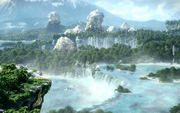
The Eorzean Realm.
In Eorzea, towering mountains dominate the north, their peaks lashed with icy winds, and to the south, a bleak expanse of unforgiving desert holds sway. These inhospitable lands hold lure for man and monster alike, being rich in aether. Aether is the magical source of life that flows through the planet and everything living on it. It can be used in a number of ways, including fueling magic, powering machina, aiding in crafting, quickening summoning, and allowing instantaneous teleportation through aetherytes.
Eorzea is said to cycle through prosperous Astral eras and disastrous Umbral eras. It is said that Eons ago the land was inhabited by gods and goddesses, which the wandering tribes that settled the land called the Twelve. The gods blessed the tribes that came to the savage land with welfare and prosperity, in what is known as the Age of Gods. The tribes began fighting with each other, and war tore Eorzea apart. The gods and goddesses vanished, starting the First Umbral Era. Once the chaos from this conflict subsided, and the "Spoken" were left alone with the Aetherial Sea separating them from the divine, the earliest civilizations came to Eorzea, marking the dawn of the First Astral Era. There have been six great eras of calamity since the Age of Gods passed into legend and the age of man began. Each of the Umbral catastrophes has, in turn, borne the characteristics of one of the six elements.
With the end of the Sixth Umbral Era, all the elements had been represented, and it was believed the Sixth Astral Era would last into eternity. With the end of Final Fantasy XIV 1.0, and the fall of Dalamud, a period known as the Seventh Umbral Era has started. The unleashing of Bahamut has destroyed much of the land, and numerous other dark omens signal great suffering to come. The A Realm Reborn relaunch takes place in this Seventh Umbral Era.
Three major city states exist within Eorzea: the bustling commercial hub of Ul'dah, the forest nation of Gridania, and the marine city-state of Limsa Lominsa. Each state hosts a Grand Company—economic and military organization tasked with defending the land. Adventurers join these organizations to further their goals and ambitions, while simultaneously helping keep the peace over Eorzea. Two other city-states also exist: the reclusive Holy See of Ishgard, which has been continually warring with the draconic Dravanian Horde, and Ala Mhigo, a militaristic, once-powerful city-state in Eorzea's northeast which fell to the Garlean Empire twenty years ago during Garlemald's initial invasion. In addition, the distant scholarly city of Sharlayan had until recently maintained a colony in Dravania, and is deeply involved in the politics and fate of Eorzea.
Eorzea's main enemies consist of the Beast Tribe races and the Garlean Empire. The Beast Tribes are a group of intelligent clans on the edges of society, whose ideals and objectives clash with the "enlightened" races, often summoning their gods against the city states, while the Garlean Empire is a magically weak but technologically superior nation hailing from outside of Eorzea who seeks to conquer the land with their ceruleum-powered magitek armor and airships. In addition, threats from the hellish "void" frequently trouble the realm, as do the machinations of a mysterious shadowless cult.
City states[]
Limsa Lominsa[]
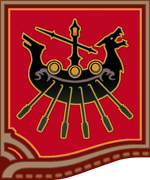
The Limsa Lominsan flag.
On the southern coast of the island of Vylbrand, under the shadow of ancient cliffs worn by the relentless onslaught of the Rhotano Sea, lies the marine city-state of Limsa Lominsa. Said to be blessed by the goddess of navigation, Llymlaen, the city is spread out over countless tiny islands, each connected by sturdy bridges of iron and wood construction, earning her the name the "Navigator's Veil" from traveling bards who have witnessed the city's beauty from afar.
Limsa Lominsa is a thalassocracy, a former pirate state with power lying in the hands of the ruling party and its leader, the Admiral. Its economy is driven by shipbuilding, fishing, and blacksmithing, but the majority of wealth comes from the lucrative shipping industry.
To maintain the safety of its maritime routes, the city employs a formidable navy known as the Knights of the Barracuda. However, even in the waters nearby the city, unaffiliated pirate bands run rampant, raving and pillaging.
Gridania[]
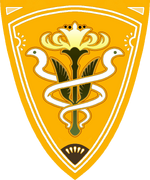
The flag of Gridania.
In the eastern reaches of the Aldenard landmass, home to vast, dense woodlands and coursing rivers, lies the forest nation-state of Gridania. The cityscape is a mosaic of labyrinthine waterways and great wooden structures, so gracefully constructed they seem a part of the surrounding environment.
The Gridanian emphasis on natural harmony has led to its preeminence among Eorzea's city-states in trades such as forestry, agriculture, carpentry, and leatherworking. Gridania is home to the Wood Wailers, a militant band of polearm-wielding sentries charged with the protection of their homeland.
The favored goddess of the citizenry is Nophica, the Matron, but great faith is also placed in the wisdom of the Seedseers—young oracles who guide the nation based on the will of the forest's elementals.
Ul'dah[]
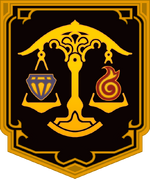
The flag of Ul'Dah.
The bustling commercial hub of Ul'dah sits amid the arid desert landscape of Thanalan in southern Aldenard. The city is organized strategically around the dome-shaped citadel at its center. Its towering fortifications and protective outer walls are visible for malms in all directions, and serve as a stark deterrent to would-be besiegers.
Visitors from every corner of Eorzea come to Ul'dah to partake of the city's famed recreation, most notably the fighting arenas and gambling halls. Ul'dahn culture is known for its affluence, and the nation's wealth comes from its abundant mineral resources and prestigious clothcrafting industry.
Historically, the sultanate claims sovereignty over Ul'dah, but true power is wielded by the Syndicate, an elite group of six of the most influential and richest members of society, puppeting the current Sultana. Nald'thal, the Traders is the city's patron deity and two great halls devoted to his two aspects—Nald and Thal—are found in the eastern and western sections of the city.
Ishgard[]
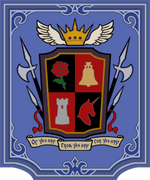
The flag of Ishgard.
In the central region of Abalathia's Spine, that great mountain range that spans Aldenard from east to west, can be found the forbidding highlands of Coerthas and the Holy See of Ishgard. The archbishop of the church, while leading his people in the teachings of Halone, the Fury, rules also as the nation's sovereign.
Ishgard's formidable army of knights wages constant battle against its mortal enemies, the dragons. Faced with ever more aggressive attacks from its serpentine foes, as well as an unprecedented spell of bitter cold, the theocracy's days are dark indeed. Matters have grown so grave as to prompt the archbishop and his advisors to consider throwing open the heretofore sealed gates of Ishgard and calling for outside aid.
Ala Mhigo[]
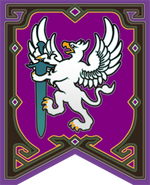
The flag of Ala Mhigo.
The highlands of Gyr Abania in the eastern reaches of Aldenard were once under the control of a martial nation known as Ala Mhigo. It was, perhaps, the historically conflicted nature of the territory that forged the country into a significant military power.
Even as this aggressive nation sent its forces to conquer in the west, it repelled repeated attempts at invasion from the east. In the Year 1557 of the Sixth Astral Era, however, it finally fell to the incursions of the Garlean Empire. From that time onwards, the country became merely another imperial territory under the governance of its usurpers. Though the people of Ala Mhigo once revered Rhalgr, the Destroyer, as their patron deity, any such religious observance has since been forbidden by the controlling authorities.
Grand Companies of Eorzea[]
These are the groups being formed by the city-states to combat the coming and current threat of the Garlean Empire, as well as clashes with the beast-tribes.
The Maelstrom of Limsa Lominsa[]
At the heart of the Thalassocratic Navy lies the Lominsan Armada, composed of nine independent squadrons, the First through the Ninth. The Maelstrom is an extension of the First Squadron, expanding its role as armada flagship and granting it power to administer not only the remaining eight squadrons, but the various merchant fleets that navigate the seas off Vylbrand.
With the reestablishment of the Maelstrom, the Admiral has begun the move to invoke ancient maritime law, by which she would promote herself to Chief Admiral, effectively expanding her authority to cover not only state and military dealings, but grant her the power to directly command all ships in Lominsan waters, and freely punish any who disobey. The city-state's pirates are not about to take this encroachment on their freedom without a fight.
Gridania's The Order of the Twin Adder[]
The Order of the Twin Adder establishes a medium from which the Seedseers can return from their wanderings deep within the Black Shroud and directly oversee not only the safety of Gridania's citizens, but the workings of the local guard. Both the Gods' Quiver, who defend the forest from external threats, and the Wood Wailers, who protect it from internal strife, have expressed their support of this temporary measure.
There are those within Gridania who would question the ability of the Seedseers, whose duties until now have been limited to various ritualistic proceedings, and doubt whether or not they are fit to lead a nation into war.
The Immortal Flames of Ul'dah[]
Currently, the bulk of Ul'dah's military strength comes from their standing army of mercenaries and the small contingent of the palace guard known as the Sultansworn. To bring order to their ranks and oversee additional wartime training, the Sultana has considered resurrecting the Immortal Flames—an elite force of battle-hardened veterans that once instilled fear in the city-state's neighboring nations during ages past.
This unit would act as a core aspect of the army bolstering its power, and grant more authority to the Sultana and her advisers—something of which those in control of the city-state's economy—namely the Syndicate—are wary.
Transportation[]
The player characters move quickly from place to place by using aetherytes, large shards of crystallized aether fused with ancient machinery. These crystals act as teleporters, for a fee. In 1.0, this was limited by the amount of "Anima" points the player had, but in A Realm Reborn, the fee is in gil instead. One can also set three Aetherytes as "favorites", reducing teleport costs to that Aether by half, and one as "home", reducing teleport costs to that Aether to zero. Teleporting to one's home aetheryte for free is limited to once every fifteen minutes, but the player can return there whether this time has elapsed or not as long as they have been KO'd. Players with a one time password attached to their account can set one Aetheryte to be free of charge for teleporting at any time. PlayStation Plus subscribers can register an additional free teleport by claiming a reward from the PlayStation Store, and must be refreshed every thirty days.
Players can also obtain mounts for swift movement within a zone. This includes a chocobo issued from a Grand Company, as well as other exotic steeds and even Magitek Armor. Some are even capable of flight, enabling access to hard to reach areas. Ferry and airship services can be obtained at the major cities and certain hamlets.
Activities[]
Gold Saucer[]
Introduced in Patch 2.51, the Gold Saucer is an amusement park players may visit once they've completed all the initial Main Scenario quests for their starting nation. The Gold Saucer enables players to play Triple Triad, race Chocobos, and participate in a variety of minigames.
Guildleves[]
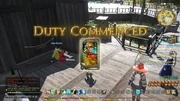
A Guildleve.
The player character must join a guild to receive Guildleves, decorative cards that hold a quest for the character to complete. The quests can include anything from hunting a specific monster to item collection or negotiation with the enemies. The Guildleves can be completed alone or with a party of other players, with everyone reaping the benefits of the quest. The players can multitask on several leves at the same time.
Story[]
- This section contains a brief summary of Final Fantasy XIV's lore and story. For a comprehensive explanation of the Final Fantasy XIV storylines, please see Final Fantasy XIV storylines.
Five years before the events of the story, metal-clad warriors invaded Eorzea with flame-spewing weapons and colossal airships. The army came from the Garlean Empire, and it didn't take long before the mightiest of the six city-states, Ala Mhigo, fell under their force. The other city-states united their power to defend themselves, but just as fast as it had arrived, the imperial army was gone. A new era began at Eorzea, known as the Age of Calm, which the city-states spent by building up their defenses and training their armies.
Before, the cities had hired mercenaries for their inner wars, but now they trusted only professional soldiers, leaving the sellswords unemployed and restless. To keep them from causing harm and steer their energy into helping others instead, the city-states founded a network of adventuring guilds.
Music[]
The original soundtrack of Final Fantasy XIV at launch was composed entirely by Nobuo Uematsu, and was the first full musical score he has composed for a Final Fantasy game in ten years, the last being Final Fantasy IX. Since the release of A Realm Reborn, Masayoshi Soken has served as sound director and lead composer. A Realm Reborn and later expansions have also featured additional new compositions by Takafumi Imamura, Daiki Ishikawa, Naoshi Mizuta, Tsuyoshi Sekito and Yukiko Takada. Uematsu has provided compositional support on several expansions, most notably the main themes for Heavensward and Stormblood.
A selection of Final Fantasy XIV 1.0's tracks have been released in two volumes named Final Fantasy XIV / Field Tracks and Final Fantasy XIV / Battle Tracks, with the entire official soundtrack of 1.0 released in Before Meteor: Final Fantasy XIV Original Soundtrack, which includes rearrangements of the series' "Main Theme", "Prologue" and the "Victory Fanfare".
The vocal theme, "Answers", is sung by American musician Susan Calloway, who is also one of the vocalists to sing "Distant Worlds" from Final Fantasy XI. She is the vocalist for the Distant Worlds concert CDs and has performed live in many of the concerts.
Expansions[]
Beginning with Heavensward, the game has adopted a standard approach to many aspects of the soundtrack. Nearly all major field zones have separate themes for day and night. Nighttime themes are typically piano arrangements of the daytime theme; similarly, duty themes are often (but not always) arrangements of the theme belonging to the area they are accessed from. Incorporation of the expansion's main theme and leitmotifs is much more prevalent than in A Realm Reborn, with the settlement themes, principal city themes, duty end boss themes and final boss themes all being heavily based around the central melody.
All expansions feature arrangements of tracks from previous Final Fantasy games, including such mainstays as "Matoya's Cave". Stormblood also features music taken directly from Chocobo no Fushigina Dungeon, Final Fantasy Tactics, Final Fantasy XI, the Zodiac Age edition of Final Fantasy XII and Vagrant Story, while Shadowbringers features music (as well as special arrangements) from NieR:Automata. Crossover events with Final Fantasy XI, Final Fantasy XIII, Final Fantasy XV and Final Fantasy XVI have also featured a small selection of tracks from their respective games. The Palace of the Dead deep dungeon storyline uses music taken directly from Tactics Ogre: Let Us Cling Together.
Tracks added in earlier expansions are often reused in later patches.
The addition of the Orchestrion feature in Patch 3.2 allows players to listen to the game's music in city inn rooms, apartments, houses, private rooms and the player's Island Sanctuary, as long as they possess the relevant Orchestrion Roll. Most - but not all - tracks played in the game can be acquired as Orchestrion Rolls from shops, duties or miscellaneous achievements. Certain Rolls (such as those featured during past seasonal or special events, or on remix/arrangement albums) can also be purchased from the Mogstation.
Development[]
A new age is upon us... and we fight, to make it ours.
Final Fantasy XIV: A Realm Reborn Game Trailer
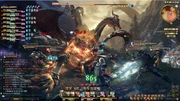
A conceptual screenshot of the "2.0" update.
In the wake of the disastrous launch of the original version, and the backlash the game received from players, critics and investors,[3] Square Enix announced the development of a "2.0" update to the game, titled "A Realm Reborn: Final Fantasy XIV" (or "Shinsei Eorzea"/"Reborn Eorzea" in Japanese) on October 14, 2011. A Realm Reborn would be the culmination of the cycle of updates to the game that began after the staff replacements earlier that year. A Realm Reborn was pitched not as an expansion pack, but an entire reworking of the game, rebuilt from the ground up.
The update requires an all new client, currently available for free download for all purchasers of 1.0. It uses a different graphics engine, based on a branch of Square's Luminous technology and drastically redesigns the game world map for ease of use and play and boasts a different server structure which allows for more rapid player action; the new engine is also better optimized for both lower end PCs and the PlayStation 3. The main storyline is modified to fit in with the new Eorzea, but does hit a number of similar plot beats to the original storyline; the new story is set five years after the fall of Meteor and the end of Legacy.
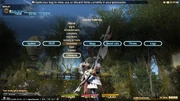
A screenshot of PlayStation 3 version, showcasing the new UI.
During E3 2012, new information regarding the release for the PlayStation 3 version and the 2.0 revision of the game, along with new screens and artwork of the content for the update, was released. It included concept art for Typhon, a series recurring enemy, Fenrir with a design similar to that of the one seen in Final Fantasy XI, new screenshots of male Miqo'te as a Paladin and another as a Dragoon, as well as many new weapons and equipment. The first gameplay presentation was shown at Gamescom,[4] and the Final Fantasy 25th Anniversary event on September 1 featured a keynote with Naoki Yoshida.[5]
On July 5, 2012, Square Enix launched a new teaser site, which was constantly updated with information, including a blog with weekly updates concerning everything from teases to new content to the occasional bit of office shenanigans.
The Alpha Test, conducted during the last several weeks of 2012, was an encouraging success. Many praised the Alpha for having far more content than was needed to conduct server stress tests.
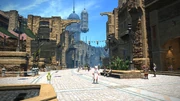
Ul'dah during the beta test.
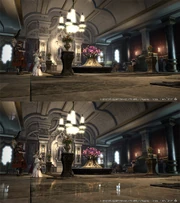
Comparison screenshots of DirectX 9 (Top) and DirectX 11 (Bottom).
The Beta Test application site was open from early 2013 until late July of that year, and the A Realm Reborn beta commenced on February 25, 2013, with testing coming to a successful close on August 19. Legacy members and players with a Final Fantasy XIII Members Registration Code were given priority for selection in Phase 1 of the Beta, but more testers were invited regularly; Phase 4 was an "open beta" in which virtually everyone who applied before the July cut-off was allowed in, and progress made carried forward into the release game.
This resulted in several problematic errors on the North American server cluster that caused some people to get locked out of the game, but these were largely caused by congestion as the beta shattered player-concurrency records, not just for Final Fantasy XIV but for any massively-multiplayer open beta, anywhere.[6] This necessitated the emergency opening of whole new servers, which were quickly filled.
In July 2014 Square Enix's Final Fantasy XIV development team was recorded as saying the team has progressed their planning to about four years into the future.[7]
Starting with Heavensward expansion, Final Fantasy XIV became available for Mac users and also supports DirectX 11.
In July 2020, ahead of the release of patch 5.3, Square Enix announced that it would incorporate Heavensward content into the free trial.
In February 2021, during the Endwalker showcase, Square Enix announced that a PlayStation 5 beta would coincide with patch 5.5 on April 13, 2021. The PlayStation 5 version officially entered service on May 25, 2021, coinciding with patch 5.55.
In July 2023, during the Final Fantasy XIV Fan Festival in Las Vegas, Yoshida and Microsoft Gaming CEO Phil Spencer jointly announced that Final Fantasy XIV would launch on Xbox Series X and S, and entered open beta on February 21, 2024. The Xbox Series X and S version officially entered service on March 21, 2024.
Major updates[]
A Realm Awoken (2.1)[]

A Realm Awoken logo.
The first major patch update for Final Fantasy XIV: A Realm Reborn was released on December 17, 2013. The main scenario saw the Scions investigate the ongoing summoning of primals by the beast tribes, with questions raised about their nature when the moogles summoned their ancient king Moggle Mog XII as a primal in ![]() Thornmarch (Hard).
Thornmarch (Hard).
Several other new duties were introduced in side storylines. The first Extreme difficulty trials of A Realm Reborn were added to the Primals side story in the form of ![]() The Howling Eye (Extreme),
The Howling Eye (Extreme), ![]() The Navel (Extreme),
The Navel (Extreme), ![]() The Bowl of Embers (Extreme), while the Wandering Minstrel spun his first tall tale in
The Bowl of Embers (Extreme), while the Wandering Minstrel spun his first tall tale in ![]() The Minstrel's Ballad: Ultima's Bane. Three new dungeons were added:
The Minstrel's Ballad: Ultima's Bane. Three new dungeons were added: ![]() Pharos Sirius,
Pharos Sirius, ![]() Copperbell Mines (Hard), and
Copperbell Mines (Hard), and ![]() Haukke Manor (Hard).
Haukke Manor (Hard). ![]() The Labyrinth of the Ancients was added as the first 24-man raid of the Crystal Tower series where players get into one of three full party groups.
The Labyrinth of the Ancients was added as the first 24-man raid of the Crystal Tower series where players get into one of three full party groups.
Company housing, the duty roulette, the Wolves' Den, treasure hunts, and amalj'aa and sylph beastmen sidequests were all added to the game. The Aesthetician, Jandelaine de Dzemael, allowed the players to change their hairstyle and hair color. Lightning and Snow's hairstyles are also available for players who finished the quest Lightning Strikes.
Through the Maelstrom (2.2)[]
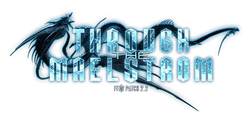
Through the Maelstrom logo.
Released on March 27, 2014. The main scenario saw the Scions learn more about the nature of the Echo as they contended with the Sahagin primal Leviathan on ![]() The Whorleater (Hard), while also dealing with a new crisis when refugees from the far eastern land of Doma seek asylum in Eorzea.
The Whorleater (Hard), while also dealing with a new crisis when refugees from the far eastern land of Doma seek asylum in Eorzea.
New extreme trials were added in ![]() Thornmarch (Extreme) and
Thornmarch (Extreme) and ![]() The Whorleater (Extreme). The Bahamut raid storyline continued with the addition of the Second Coil of Bahamut. New dungeons were added in
The Whorleater (Extreme). The Bahamut raid storyline continued with the addition of the Second Coil of Bahamut. New dungeons were added in ![]() The Lost City of Amdapor,
The Lost City of Amdapor, ![]() Brayflox's Longstop (Hard) and
Brayflox's Longstop (Hard) and ![]() Halatali (Hard), while the continuing adventures of Hildibrand Manderville resulted in the saw players do duel with Gilgamesh in a
Halatali (Hard), while the continuing adventures of Hildibrand Manderville resulted in the saw players do duel with Gilgamesh in a ![]() Battle on the Big Bridge.
Battle on the Big Bridge.
The patch also included new beastmen daily quests focusing on the sahagin and kobold tribes and the addition of the Glamour system, which allows players to change the appearance of their equipment.
Defenders of Eorzea (2.3)[]
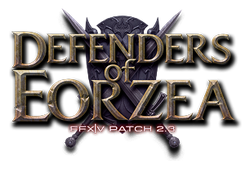
Defenders of Eorzea logo.
This update was released on July 8, 2014. The Scions traveled to the Black Shroud to contend with the sylph primal Ramuh at ![]() The Striking Tree (Hard), while Alphinaud would seek the formation of an independent grand company to solve Eorzea's woes.
The Striking Tree (Hard), while Alphinaud would seek the formation of an independent grand company to solve Eorzea's woes.
The Crystal Tower storyline continued with the ![]() Syrcus Tower raid, while the Second Coil of Bahamut (Savage) was added as a brutal challenge to players. New dungeons were added in
Syrcus Tower raid, while the Second Coil of Bahamut (Savage) was added as a brutal challenge to players. New dungeons were added in ![]() Hullbreaker Isle,
Hullbreaker Isle, ![]() The Tam-Tara Deepcroft (Hard), and
The Tam-Tara Deepcroft (Hard), and ![]() The Stone Vigil (Hard).
The Stone Vigil (Hard).
The first Frontline map, ![]() The Borderland Ruins, was released, intended for large-scale PvP. Desynthesis was introduced, allowing players to break down equipment into components. The Hunt was introduced, and Hildibrand's investigations continued.
The Borderland Ruins, was released, intended for large-scale PvP. Desynthesis was introduced, allowing players to break down equipment into components. The Hunt was introduced, and Hildibrand's investigations continued.
Dreams of Ice (2.4)[]
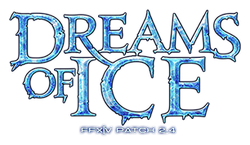
Dreams of Ice logo.
This updated was released on October 28, 2014. The Scions aided Ishgard in their efforts against Dravanian heretics, travelling through ![]() Snowcloak to confront the primal Shiva in the
Snowcloak to confront the primal Shiva in the ![]() The Akh Afah Amphitheatre (Hard). Elsewhere, the Crystal Braves would unearth a spy in the Immortal Flames' midst.
The Akh Afah Amphitheatre (Hard). Elsewhere, the Crystal Braves would unearth a spy in the Immortal Flames' midst.
The Bahamut raid storyline concluded in the the Final Coil of Bahamut. Additional dungeons were added in ![]() Sastasha (Hard) and
Sastasha (Hard) and ![]() The Sunken Temple of Qarn (Hard), while Hildibrand's investigations led to conflict with Ultros and Typhon in
The Sunken Temple of Qarn (Hard), while Hildibrand's investigations led to conflict with Ultros and Typhon in ![]() The Dragon's Neck.
The Dragon's Neck.
The new ![]() Rogue class and its upgrade
Rogue class and its upgrade ![]() Ninja were introduced in 2.4. Allagan tomestones of poetics were implemented into the game for equipment exchange. Poetics would go on to be the longest tenured tomestones, replacing all future tomestones as they were discontinued.
Ninja were introduced in 2.4. Allagan tomestones of poetics were implemented into the game for equipment exchange. Poetics would go on to be the longest tenured tomestones, replacing all future tomestones as they were discontinued.
Before the Fall (2.5)[]

Before the Fall logo.
Before the Fall was split in three parts, with 2.5 released on January 20, 2.51 on February 24, and 2.55 on March 31, 2015.
The main scenario saw the Scions investigate ![]() The Keeper of the Lake in response to increasing Dravanian activity and face off against the Ascian Nabriales in
The Keeper of the Lake in response to increasing Dravanian activity and face off against the Ascian Nabriales in ![]() The Chrysalis. They would then assist in the defense of
The Chrysalis. They would then assist in the defense of ![]() The Steps of Faith from the Dravanian Horde before attending a celebratory banquet in Ul'dah.
The Steps of Faith from the Dravanian Horde before attending a celebratory banquet in Ul'dah.
Additional dungeons included ![]() The Wanderer's Palace (Hard) and
The Wanderer's Palace (Hard) and ![]() Amdapor Keep (Hard). The final chapter of the Crystal Tower story arc would see players confront the Cloud of Darkness in
Amdapor Keep (Hard). The final chapter of the Crystal Tower story arc would see players confront the Cloud of Darkness in ![]() The World of Darkness, and Hildibrand's story would conclude with another duel against Gilgamesh in the
The World of Darkness, and Hildibrand's story would conclude with another duel against Gilgamesh in the ![]() Battle in the Big Keep. In the Black Shroud, players could face off against the elusive primal Odin in
Battle in the Big Keep. In the Black Shroud, players could face off against the elusive primal Odin in ![]() Urth's Fount. A new PVP mode in Frontline, called Slaughter, was also added.
Urth's Fount. A new PVP mode in Frontline, called Slaughter, was also added.
Patch 2.51 saw the release of the Manderville Gold Saucer for players to compete in minigames. Triple Triad and Chocobo Racing were introduced as features of the park. The final stage of the Zodiac Weapons were introduced.
Expansions[]
Heavensward (3.0)[]
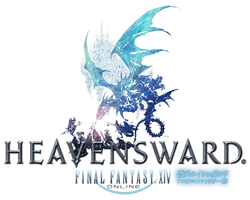
Heavensward logo.
The first expansion pack was announced on October 18, 2014. It was released on June 23, 2015, with early access for pre-orders opening on June 19.[8]
Two new major plotlines were introduced in the expansion: The Dragonsong War, the tale of the 1000-year conflict between the Dravanian Horde and Ishgard, and the tale of "Thordan and his Knights Twelve" against the Horde. The city of Ishgard opened its gates to outsiders for the first time, granting access to the wilderness of Coerthas and the Dravanian lands. New sky zones were introduced, along with flying mounts and player airships.
The level cap was increased to 60. Three new jobs were introduced: ![]() Dark Knight,
Dark Knight, ![]() Machinist, and
Machinist, and ![]() Astrologian. New beast tribes were introduced in the Vanu Vanu and Gnath, as well as their primals Bismarck and Ravana. The citadel alexander provides the setting for the new top-tier raid in the game, while the Shadow of Mhach alliance raid series loomed in the Sea of Clouds. The Au Ra, a race of draconic humanoids, were introduced as playable characters.
Astrologian. New beast tribes were introduced in the Vanu Vanu and Gnath, as well as their primals Bismarck and Ravana. The citadel alexander provides the setting for the new top-tier raid in the game, while the Shadow of Mhach alliance raid series loomed in the Sea of Clouds. The Au Ra, a race of draconic humanoids, were introduced as playable characters.
As of August 11, 2020, Heavensward is included with the Starter Edition and free trial of the game.
Stormblood (4.0)[]
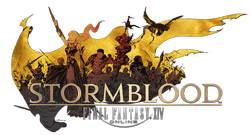
Stormblood logo.
The second expansion pack was announced on October 14, 2016. It was released on June 20, 2017, with early access for pre-orders opening on June 16.
The plot centers around efforts to liberate Ala Mhigo and Doma after two decades of subjugation under the Garlean Empire. Adventurers may now cross into the imperial territory of Gyr Abania as well as visit the Far Eastern shores of Othard, along with the exotic port city of Kugane. Six new outdoor zones were added, and the ability to dive underwater was added for further exploration. Two new jobs were added, ![]() Samurai and
Samurai and ![]() Red Mage, with the existing jobs significantly rebalanced to reduce ability bloat. New beast tribes were introduced in the Kojin and Ananta, as well as their primals Susano and Lakshmi. A new raid series series surrounding Omega was added, as was a Return to Ivalice alliance raid series. The level cap was increased to 70.
Red Mage, with the existing jobs significantly rebalanced to reduce ability bloat. New beast tribes were introduced in the Kojin and Ananta, as well as their primals Susano and Lakshmi. A new raid series series surrounding Omega was added, as was a Return to Ivalice alliance raid series. The level cap was increased to 70.
As of October 2, 2023, Stormblood is included with the Starter Edition and free trial of the game.
Shadowbringers (5.0)[]
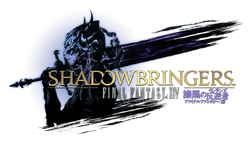
Shadowbringers logo.
The third expansion pack was announced on November 16, 2018. It was released on July 2, 2019, with early access for pre-orders opening on June 28.
The story sees players travel to the First, set in the crumbling region of Norvrandt, where the world has been overrun with Light, featuring deadly new enemies called Sin Eaters. Two new main hub areas were featured on the First: the haven city known as the Crystarium, and the secluded home of the wealthy and elite, Eulmore. Two new jobs were introduced, ![]() Gunbreaker and
Gunbreaker and ![]() Dancer. Large changes were also made to the battle system, such as the removal of the TP resource and specific damage types (such as piercing or blunt), as well as overall job rebalance. The level cap was raised to 80, and new abilities were added to each existing job. Two new playable races were also added: the much requested Viera, locked only to female characters, as well as the male-only beastial Hrothgar. The Final Fantasy VIII-themed Eden raids were added, in addition to the YoRHa: Dark Apocalypse alliance raids, a NieR:Automata crossover with special guest designers Yoko Taro and Yosuke Saito.
Dancer. Large changes were also made to the battle system, such as the removal of the TP resource and specific damage types (such as piercing or blunt), as well as overall job rebalance. The level cap was raised to 80, and new abilities were added to each existing job. Two new playable races were also added: the much requested Viera, locked only to female characters, as well as the male-only beastial Hrothgar. The Final Fantasy VIII-themed Eden raids were added, in addition to the YoRHa: Dark Apocalypse alliance raids, a NieR:Automata crossover with special guest designers Yoko Taro and Yosuke Saito.
Endwalker (6.0)[]
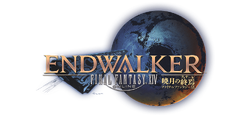
Endwalker logo.
The fourth expansion pack was announced on February 5, 2021. It was released on December 7, 2021, with early access for pre-orders opening on December 3.
The story of the expansion serves as an ending to Hydaelyn—Zodiark story arc, which started in A Realm Reborn. The players seek out a way to avert the Final Days foreshadowed in the previous expansion. The expansion introduces two new hub areas, Old Sharlayan and Radz-at-Han. Two new jobs were introduced, ![]() Sage and
Sage and ![]() Reaper. Balance changes to previous jobs were made, and
Reaper. Balance changes to previous jobs were made, and ![]() Astrologian was transformed into pure healer, similar to that of a
Astrologian was transformed into pure healer, similar to that of a ![]() White Mage. Level cap was raised to 90 and each existing job received new abilities. No new playable races were added, but the Viera race received a male variant, with Hrothgars expected to receive a female variant at a later date.
White Mage. Level cap was raised to 90 and each existing job received new abilities. No new playable races were added, but the Viera race received a male variant, with Hrothgars expected to receive a female variant at a later date.
Dawntrail (7.0)[]
The fifth extension was announced on July 28, 2023 and was released on July 2, 2024, with early access for pre-orders opening on June 28.
Players are called to "the New World" to the west, known to the locals as Tural, to aid in a contest of succession.
Release[]

PlayStation 4 and Final Fantasy XIV: A Realm Reborn bundle.
A Realm Reborn launched as scheduled on August 27, 2013, on both the PC and with the long-awaited PlayStation 3 version. Players who pre-ordered A Realm Reborn got "early access" on August 24.
The Steam version was released on February 17, 2014. Both Standard and Digital Collector's Editions are available.
The PlayStation 4 version was released on April 14, 2014. Players of the PS3 version were able to upgrade to the PS4 version for free.[1]
The PlayStation 5 version entered open beta with the release of patch 5.5 on April 13, 2021, and allowed players of the PS4 version to upgrade for free. It entered service on May 25, 2021 with the release of patch 5.55.
The limited edition of the PlayStation 4 bundled with Final Fantasy XIV: A Realm Reborn was available in Sony Japan stores, limited to only 1,400 units. The package included a 500 GB PlayStation 4 console with a laser etched hard drive bay cover and a copy of Final Fantasy XIV: A Realm Reborn on disc.
Final Fantasy XIV: A Realm Reborn Game of the Year Edition was released on November 14, 2014, and only available for PC and comes bundled in a printed Book of Diamonds Grimoire box, along with five art cards and 90 days worth of subscription to the game.[9]
Final Fantasy XIV Online Complete Edition was released on June 23, 2015, bundling both A Realm Reborn and Heavensward. It was refreshed to include Stormblood on June 20, 2017, with Shadowbringers on July 2, 2019, with Endwalker on December 7, 2021, and with Dawntrail on July 2, 2024.
During the Final Fantasy XIV Fan Fest 2023 in Las Vegas, director Naoki Yoshida and the CEO of Microsoft Games, Phil Spencer, announced that Final Fantasy XIV will be released on Xbox Series X/S in spring of 2024.
Third party services[]
Final Fantasy XIV: A Realm Reborn was published in China with full Chinese translations by Shanda Games. The Korean version is published by Actoz Soft with full Korean translations.
System requirements[]
| Minimum | Recommended | |
|---|---|---|
| OS | Windows® 7 64 bit, Windows® 8.1 64 bit, Windows® 10 64 bit | Windows® 7 64 bit, Windows® 8.1 64 bit, Windows® 10 64 bit |
| Processor | Intel® Core™ i5 2.4 GHz or higher | Intel® Core™ i7 3 GHz or higher |
| Memory | 4 GB RAM | 8 GB RAM |
| Graphics | NVIDIA® Geforce® GTX 750 or higher, AMD Radeon™ R7 260X or higher | NVIDIA® Geforce® GTX 660 or higher, AMD Radeon™ HD 7950 or higher |
| Screen Resolution | 1280x720 | 1920x1080 |
| Hard Drive | 60 GB available space | 60 GB available space |
| Sound Card | DirectSound® compatible sound card | DirectSound® compatible sound card |
| Network | Broadband Internet connection | Broadband Internet connection |
| Others | DirectX 9.0c and DirectX 11 Square Enix account |
DirectX 9.0c and DirectX 11 Square Enix account |
Reception and sales[]
Early previews and reception of A Realm Reborn were more positive than reception of Version 1.0 was, with many previews extolling the virtues of the revised game,[10][11][12][13] and with major news site Destructoid awarding A Realm Reborn a "Best MMO of E3 2013" award.[14]
Among the fan community, A Realm Reborn received some criticism for the difficulties connecting to the game during "prime time" hours in the game's first week or so of service. This was due to unprecedented interest and sales which exceeded Square Enix's projections and led to every server being at capacity before even the end of early access; even the beta was breaking concurrency records,[6] and the game's release saw concurrency go even higher with still greater sales, necessitating significant expansion of the data centers for both major regions.[15]
Reviews have been substantially more positive than ones of the original version with the release currently holding an 83/100 on Metacritic for the PC version,[16] a 78/100 for the PS3 version,[17] and an 86/100 for the PS4.[18] USGamer gave the game a perfect score, saying: "Square Enix has pulled off the seemingly impossible: rescuing a disastrous flop of an online game without going free-to-play, and creating an incredibly addictive, satisfying experience for both MMO and Final Fantasy veterans in the process. A Realm Reborn is a triumph for Naoki Yoshida and his team."[19] Even sites previously harshly critical of the original, such as IGN, rated the game highly, saying: "Grounded in tradition and learning from the lessons of the games that preceded it, it thrives on the strength of its excitingly varied and flexible class system and highly mobile combat.[...]But considering the stunning reversal of fortune that Square has achieved here, it seems like anything is possible."[20]
The game went on to sell a million and a half copies in its first month of renewed operation, and in its first month where a paid subscription was required, immediately surpassed the concurrent subscriber record of Final Fantasy XI, with over 600,000 subscribers.[21] The game's success was, in part, responsible for a reversal of Square Enix's fortunes from making a loss to making a profit in the quarter in which it was released.[22]
According to Square Enix's announcement, Final Fantasy XIV: A Realm Reborn reached 2 million registered users in April 2014.[23] In February 2015, it was announced to have reached 4 million accounts.[24]
At the 2017 Final Fantasy XIV Fan Festival in Frankfurt, during the Letter from the Producer Live, Final Fantasy XIV was awarded three Guinness World Records at a special ceremony: for "longest end credits in an MMO videogame" (1 hour and 38 minutes), the "most original pieces of music in a videogame" (384 original compositions), and for the Final Fantasy franchise as a whole the "most prolific RPG Series" (87 titles).[25]
Related media[]
A miniseries related to the game, titled Final Fantasy XIV: Dad of Light, was released in 2017.[26] A crossover manga with Saki, titled Saki & Final Fantasy XIV, was launched in Japan in January 2021.[27] A second manga series, Final Fantasy XIV: Eorzea Academy, was released in December 2021.
Production credits[]
| Producer and Director | Naoki Yoshida |
|---|---|
| Lead Artist | Akihiko Yoshida |
| Main Theme Composer | Nobuo Uematsu |
| Title Logo Designer and Image Illustrator | Yoshitaka Amano |
| Technical Director | Yoshihisa Hashimoto |
| Assistant Directors | Hiroshi Takai Kazuya Niinou |
| Assistant Producer | Nao Matsuda |
| Lead Game Designers | Naoki Yoshida Nobuaki Komoto |
| Main Scenario Writer | Kazutoyo Maehiro |
| World Lore Creators | Banri Oda Yaeko Sato |
| Battle System Director | Akihiko Matsui |
| Lead Battle System Designer | Mitsutoshi Gondai |
| Lead Monster Planner | Daisuke Sase |
| Lead Level Planner | Arata Takahashi |
| Lead Game Content Designer | Toshiaki Suzuki |
| Lead Crafting, Gathering, and Item Planners | Yousuke Hayashi Yusuke Kigoshi |
| Lead In-Game Community Planner | Kenji Muraoka |
| Lead UI Artist | Hiroshi Minagawa |
| Lead UI Designer and Technical Artist | Shinpei Sakata |
| Lead Designer | Takeo Suzuki |
| Lead Character Artists | Keiichi Baba Haruya Ishii |
| Lead Background Artist | Junichi Murata |
| Lead Animator | Shintaro Tamai |
| Lead Cutscene Artists | Masaki Imamura Yuichi Kikuchi |
| Lead Programmer | Hideyuki Kasuga |
| Lead Server System Programmer | Yoshikazu Takahashi |
| Lead UI Programmer | Keiji Noda |
| Lead Client Programmer | Mamoru Oyamada |
| Lead Graphics Programmers | Kei Honda Hideyuki Takahashi |
| Lead Tool Programmer | Kazuhito Yoshida |
| AI Technical Adviser | Youichiro Miyake |
| Lead Information Programmer | Youichirou Shimada |
| Lead Web Programmer | Keisuke Tanaka |
| Lead Project Manager | Toshiaki Shiwaku |
| The Lodestone and Companion Application Team Leader | Hiroyuki Takachi |
| Sound Director/Composer | Masayoshi Soken |
| Localization Director | Gary Francis Manucal |
| Translation Direction & English Localization | Michael-Christopher Koji Fox |
| Global Community Producer | Toshio Murouchi |
Voice cast[]
| Character | Japanese | English |
|---|---|---|
| Hydaelyn | Masako Ikeda | Mary Elizabeth McGlynncredited as Lucy Todd |
| Gaius van Baelsar | Akio Otsuka | Richard Epcar |
| Lahabrea | Shuichi Ikeda | Kyle Hebertcredited as Kyle Herbert |
| Minfilia Warde | Miyuki Sawashiro | Amy Bolton |
| Cid Garlond | Rikiya Koyama | Grant George |
| Kan-E-Senna | Rie Tanaka | Cindy Robinson |
| Raubahn Aldynn | Hiroki Yasumoto | Jason Charles Millercredited as J.C. Miller |
| Merlwyb Bloefhiswyn | Atsuko Tanaka | Jean Gilpincredited as Jean Elizabeth |
| Yda Hext | Aya Endo | Mela Lee |
| Papalymo Totolymo | Eri Kitamura | Steve Staleycredited as Steve Cannon |
| Thancred Waters | Yuichi Nakamura | Taliesin Jaffecredited as T. Axelrod |
| Y'shtola Rhul | Ai Kayano | Emily O'Brien |
| Urianger Augurelt | KENN | Gideon Emery |
| Alphinaud Leveilleur | Shinnosuke Tachibana | Sam Riegelcredited as Sam Regal |
| Alisaie Leveilleur | Rie Murakawa | Simone Bee |
| Nero tol Scaeva | Riki Kitazawa | Ian Steele |
| Livia sas Junius | Sayaka Ohara | Allison Lees Taylor |
| Rhitahtyn sas Arvina | Daichi Endo | CJ3 |
| Biggs | Go Inoue | CJ3 |
| Kuplo Kopp | Mariya Ise | Haley Alexander |
| Nanamo Ul Namo | Mariya Ise | Haley Alexander (Patch 2.0) Erin Fitzgerald (Patch 2.2+) |
| Twin Adder Dispatch | Yuki Ono | Ian Steele |
| Louisoix Leveilleur | Motomu Kiyokawa | David Lodgecredited as David V.O. Lodge |
| Yugiri Mistwalker | Rina Satoh | Paulette Ivory |
| Haurchefant Greystone | Masakazu Nishida | Jason La Shea |
| Eynzahr Slafyrsyn | Shigeo Kiyama | Grant George |
| Teledji Adeledji | Taketora | B.J. Oakie |
| Lolorito Nanarito | Hisashi Izumi | Cam Clarke |
| Ramuh | Kazuhiko Kishino | Neil Kaplancredited as Bob Johnson |
| Gilgamesh | Riki Kitazawa | Kurt Wilson |
| Ilberd Feare | Hiroshi Shirokuma | Richard Epcar |
| Aymeric de Borel | Tatsuhisa Suzuki | Blake Ritsoncredited as Bram Stormlike |
| Lucia goe Junius | Sayaka Ohara | Tara Platt |
| Shiva, Iceheart | Maaya Uchida | Salli Saffioticredited as Sally Saffioti |
| Moenbryda Wilfsunnwyn | Yu Sugimoto | Laura Post |
| Pipin Tarupin | Nobuyuki Hiyama | Max Mittelman |
| Bremondt | Toshitsugu Takashima | Neil Macbeth |
| Nabriales | Masumi Yoshida | Gideon Emery |
Packaging artwork[]
Gallery[]
Allusions[]
Final Fantasy XIV is rife with callbacks to the rest of the series and other games, movies, music, and popular culture.
See also[]
Notes[]
Annotations[]
- ↑ While Arcanist is the base class for Scholars and starts at level 1, and Scholar and Summoner share EXP, Scholars have an almost completely separate set of abilities to Arcanists/Summoners and fill a different role, effectively making them a different job that starts at 30.
Citations[]
- ↑ 1.0 1.1 Final Fantasy XIV: A Realm Reborn Coming To PlayStation 4 In April 2014 — Siliconera
- ↑ http://forum.square-enix.com/ffxiv/threads/891-Missing-Genders-A-request-for-Male-Miqote-Female-Highlander-and-Female-Roegadyn?p=86669#post86669
- ↑ Investor ragequits Square Enix over Final Fantasy XIV, sells 1% of the company (Accessed: July 23, 2020) at PC Gamer
- ↑ Final Fantasy XIV: A Realm Reborn Gameplay Will Be Revealed At Gamescom (Accessed: July 23, 2020) at Siliconera
- ↑ Future Final Fantasy XIII Developments To Be Announced on Sept. 1 (dead) (Accessed: July 23, 2012) at andriasang (dead)
- ↑ 6.0 6.1 Final Fantasy XIV: A Realm Reborn Breaks Open Beta Record (Accessed: July 23, 2020) at Gaming Reality
- ↑ Square Enix Have Planned 4 Years Into The Future For Final Fantasy XIV: A Realm Reborn (Accessed: July 23, 2020) at Siliconera
- ↑ Tweet by the official English FFXIV account (Accessed: July 23, 2020) at FF XIV EN @Twitter
- ↑ Final Fantasy 14: A Realm Reborn Game of the Year Edition Revealed (Accessed: July 23, 2020) at IGN
- ↑ 10 reasons Final Fantasy XIV: A Realm Reborn deserves a second chance (dead) (Accessed: June 09, 2013) at CVG
- ↑ Final Fantasy 14: A Realm Reborn review (Accessed: July 23, 2020) at Games Radar
- ↑ Preview: Final Fantasy XIV: A Realm Reborn Early Beta – A Seedling of Rebirth (Accessed: July 23, 2020) at Dual Shockers
- ↑ A romp through Final Fantasy XIV: A Realm Reborn (Accessed: July 23, 2020) at Destructoid
- ↑ Destructoid's Best of MMO E3 Award: Final Fantasy XIV (Accessed: July 23, 2020) at Official ''Final Fantasy XIV'' forums
- ↑ Further Details on Access Restrictions (Accessed: July 23, 2020) at Official ''Final Fantasy XIV'' forums
- ↑ Final Fantasy XIV Online: A Realm Reborn PC (Accessed: July 23, 2020) at Metacritic
- ↑ Final Fantasy XIV Online: A Realm Reborn PlayStation 3 (Accessed: July 23, 2020) at Metacritic
- ↑ Final Fantasy XIV Online: A Realm Reborn PlayStation 4 (Accessed: July 23, 2020) at Metacritic
- ↑ Final Fantasy XIV Review (Accessed: July 23, 2020) at US Gsmer
- ↑ Final Fantasy XIV: A Realm Reborn Review (Accessed: July 23, 2020) at IGN
- ↑ Final Fantasy XIV Paid Subscribers Have Already Exceeded Final Fantasy XI’s Peak (Accessed: July 23, 2020) at Siliconera
- ↑ Final Fantasy XIV’s Exceeds Square Enix’s Expectations, Prompts Earnings Forecast Increase (Accessed: July 23, 2020) at Siliconera
- ↑ Final Fantasy XIV: A Realm Reborn Reaches Over Two Million Registered Users (Accessed: July 23, 2020) at Siliconera
- ↑ Celebrating 4 Million Accounts - Free Login Campaign Comes to Eorzea! (Accessed: July 23, 2020) at ''Final Fantasty XIV'' Lodestone
- ↑ Final Fantasy XIV accepts three Guiness World Records at Frankfurt Fan Festival (Accessed: July 23, 2020) at Nova Crystallis
- ↑ Final Fantasy 14: Daddy of Light is heading to Netflix (Accessed: March 13, 2024) at ?
- ↑ Saki, Final Fantasy XIV Collaboration Manga Gets English Release (Accessed: March 13, 2024) at ?
External links[]
- Official Final Fantasy XIV Website
- Official Final Fantasy XIV Official North American Website
- Official Forums
- Final Fantasy XIV Steam Purchase Page
- Wikipedia article
- FINAL FANTASY XIV 東京ゲームショー2009 トレーラー(日本語版) (TGS2009 Trailer)
- First Letter From The Producer Live (with english subtitles)
- Second Letter From The Producer Live (with english subtitles)



